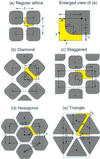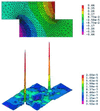Changes in brain cell shape create residual extracellular space volume and explain tortuosity behavior during osmotic challenge
- PMID: 10890922
- PMCID: PMC26943
- DOI: 10.1073/pnas.150338197
Changes in brain cell shape create residual extracellular space volume and explain tortuosity behavior during osmotic challenge
Abstract
Diffusion of molecules in brain extracellular space is constrained by two macroscopic parameters, tortuosity factor lambda and volume fraction alpha. Recent studies in brain slices show that when osmolarity is reduced, lambda increases while alpha decreases. In contrast, with increased osmolarity, alpha increases, but lambda attains a plateau. Using homogenization theory and a variety of lattice models, we found that the plateau behavior of lambda can be explained if the shape of brain cells changes nonuniformly during the shrinking or swelling induced by osmotic challenge. The nonuniform cellular shrinkage creates residual extracellular space that temporarily traps diffusing molecules, thus impeding the macroscopic diffusion. The paper also discusses the definition of tortuosity and its independence of the measurement frame of reference.
Figures







References
-
- Allbritton N L, Meyer T, Stryer L. Science. 1992;258:1812–1815. - PubMed
-
- Agnati L F, Zoli M, Stromberg I, Fuxe K. Neuroscience. 1995;69:711–726. - PubMed
-
- Agnati L F, Fuxe K, Nicholson C, Syková E. Volume Transmission Revisited. Amsterdam: Elsevier; 2000.
-
- Morrison P F, Laske D W, Bobo H, Oldfield E H, Dedrick R L. Am J Physiol. 1994;266:R292–R305. - PubMed
Publication types
MeSH terms
Grants and funding
LinkOut - more resources
Full Text Sources
Other Literature Sources

